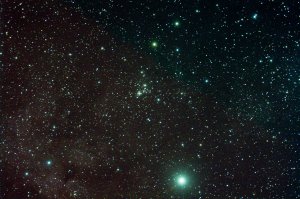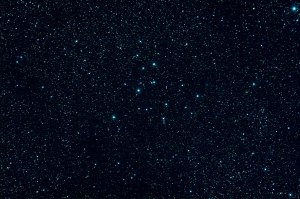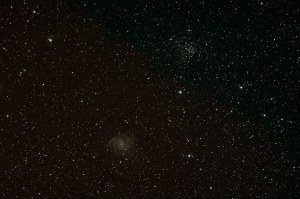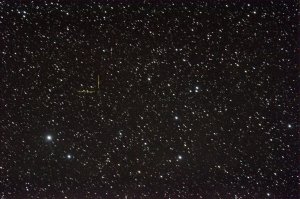Another clear sky forecast tempted me out to the Tebay road again last night. I have a list of zenith targets that will keep me going for a few sessions.
It is important to understand the limitations of your setup in astrophotography. I avoid nebulae, as the red light they emit is mostly filtered out before it reaches my camera sensor: that’s one of the disadvantages of a standard DSLR. Star clusters and galaxies are much more appropriate targets for me – along with comets, of course!
Polar alignment went like a dream this time, after the nightmare of the previous outing. The handset reported both azimuth and altitude correct to 1 arc minute, so I felt comfortable taking exposures of 60 seconds plus. With a telescope focal length of 805mm, I still think I should be able to take longer exposures than this without guiding, but further refinement will have to wait – probably when the clocks go back at the end of the month.
First up, a star cluster in Cygnus, designated NGC6910. Not large, at 10 arc minutes, it is set against the background of the Gamma Cygni Nebula at the centre of the constellation of Cygnus. That’s Sadr, the central star of Cygnus, just to the right of centre at the bottom of the frame:
Next in line is another star cluster in Cygnus, catalogued by Messier as M39. A very loose arrangement of stars covering 29 arc minutes, about the same visual size as the moon:
Very slightly west of straight up overhead, seventy stars forming the faint cluster NGC 6939 (mag 7.8), conveniently located right next to spiral galaxy NGC6946 (mag 8.8):
After the Moon sets at about half past eleven, I have a go at Comet C/2011 J2 (LINEAR) which has been reported recently as having split into two parts. At magnitude 14, it is only about 1% of the brightness of the spiral galaxy in the last photo, so it’s about as ambitious as it can be for my setup.
I catch the comet (just), but no possible trace of the split.



